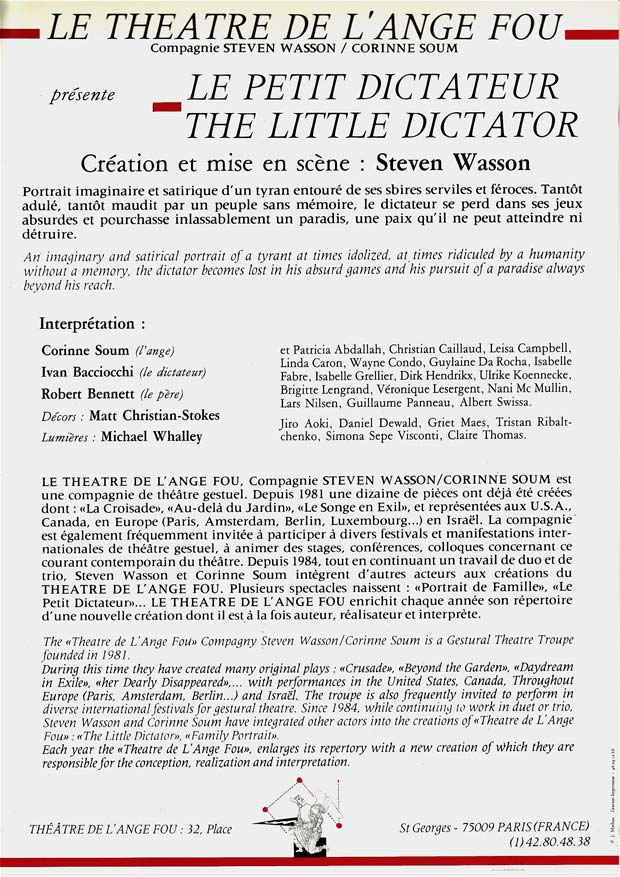The Early Years 1995-1989
 “There is nothing as fine, simple and imperceptible as those ways by which reveal ourselves. A fool enters, exits, sits, gets up, keeps silent, and stands on his legs nothing like a man of spirit.” E. DecrouxDirk (°1965) was a young welder in the small village of Hamont (Belgium) when he lost his brother. It was a turnpoint in his life. He gave up his job and opted for a different direction by applying at the Vorming voor Mimisch Theater, (Formation for mimical Theater) a school lead by Lukas Vandenabeele in Ghent, Belgium. There in 1986, Lukas pointed him towards l'École de Mime Corporel Dramatique de Paris under the educational and artistic direction of Etienne Decroux
“There is nothing as fine, simple and imperceptible as those ways by which reveal ourselves. A fool enters, exits, sits, gets up, keeps silent, and stands on his legs nothing like a man of spirit.” E. DecrouxDirk (°1965) was a young welder in the small village of Hamont (Belgium) when he lost his brother. It was a turnpoint in his life. He gave up his job and opted for a different direction by applying at the Vorming voor Mimisch Theater, (Formation for mimical Theater) a school lead by Lukas Vandenabeele in Ghent, Belgium. There in 1986, Lukas pointed him towards l'École de Mime Corporel Dramatique de Paris under the educational and artistic direction of Etienne Decroux
Etienne Decroux, one of the masters of 20th-century theatre and known as the father of modern mime, began his career in 1923 at the École du Vieux-Colombier directed by Jacques Copeau. He worked as an actor in Louis Jouvet’s and Gaston Baty’s theatre companies, at Charles Dullin’s Théâtre de l’Atelier, and in Jacques and Pierre Prévert’s films, the most famous of which Les Enfants du Paradis, by Marcel Carné.
The exercises with the neutral mask that he saw at the École du Vieux-Colombier in June of 1924, led Decroux, for over 60 years, to deepen his artistic and pedagogic research towards the development and continuous evolution of a highly codified physical theatre genre that he named corporeal mime. He studied the coordinated harmonious play of the trunk and limbs, thought and form, choosing attitude over gesture, defining movement as a succession of attitudes.
In 1940 he opened his school of corporeal mime in Paris where he taught until a few years before his death in 1991. He also taught at the Piccolo Teatro in Milan, and at the Actor’s Studio in New York. Some of his most famous students were: Jean Louis Barrault, Gerard Depardieu, Raymond Devos, Marise Flach, Jessica Lange,Marcel Marceau, Marilyn Monroe and Michel Serrault.
Continuing his formation in1987 at Theatre de l'Ange Fou, a company led by by Steven Wasson and Corinne Soum - the last two assistents of Etienne Decroux -, Dirk performed in their play Le Petit Dictateur. There he met M.A.  Affiche for Le Petit Dictateur, mentoining Dirk, Matthew, Robert, Guillaume, and UlrickeStokes, a young English poet from The King's School, Canterbury, Robert Bennett, Ulricke Koennecke and Guillaume Panneau. That group of people that shared the same interest in the works of artists like Edward Gordon Graig and Tadeusz Kantor became closely knit.
Affiche for Le Petit Dictateur, mentoining Dirk, Matthew, Robert, Guillaume, and UlrickeStokes, a young English poet from The King's School, Canterbury, Robert Bennett, Ulricke Koennecke and Guillaume Panneau. That group of people that shared the same interest in the works of artists like Edward Gordon Graig and Tadeusz Kantor became closely knit.